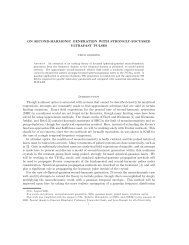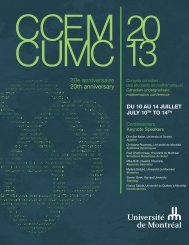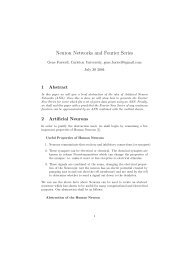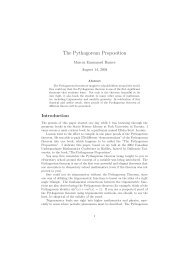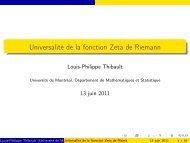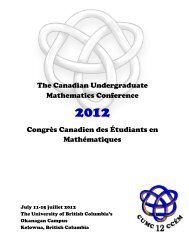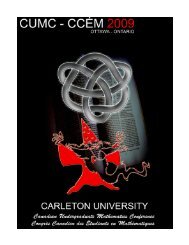booklet - CUMC - Canadian Mathematical Society
booklet - CUMC - Canadian Mathematical Society
booklet - CUMC - Canadian Mathematical Society
You also want an ePaper? Increase the reach of your titles
YUMPU automatically turns print PDFs into web optimized ePapers that Google loves.
QUANTUM CRYPTOGRAPHY, HOW THE WISES GUYS USE THE LAWS OF NATURE TOACHIEVE PERFECT SECRECYSERGE-OLIVIER PAQUETTEWith the advances in quantum mechanics, researchers around the world are on theverge of achieving the first quantum computer. Having profound consequences onthe way we compute, a quantum calculator the size of a dust grain will theoreticallybe able to factor large numbers into prime factors at a speed exponentially faster thanthe sum of all supercomputers actually on Earth, thus breaking the standards cryptographicprotocols. We will discuss how quantum mechanic is in fact the solution to thisproblem, and how the strange phenomenon that it predict will be the key to achieveperfect secrecy.Required Background: Linear AlgebraMODELING REFLECTION GROUPS IN 3DSIMON DUONG AND AFFAN SHOUKATA root system is a finite collection of vectors which is closed under a reflectionproperty. The reflections of a root system across the hyperplanes perpendicular to thesevectors forms a group. The roots systems have been given names (’types’) and there are4 infinite families plus a few exceptional cases. We took the root system A 3 , intersectedin with a sphere of radius 1 and projected it into 2 dimensions. Similarly, we furthertook root system A 4 , intersected it with a 4 dimensional sphere of radius 1 and projectedit into 3 dimensions. A 3D model was generated and printed with a 3D printer.THE CLASS NUMBER AND MINKOWSKI’S BOUNDSIQI WEIIn proving Fermat’s Last Theorem, one of the main difficulties is to determine theunique factorization property of the ring Z[ω], which is measured by the class number.This talk will introduce the class number, discuss one way of determining it, and showsome of the drawbacks when using it.NUMERICAL SOLUTIONS TO THE SCHRODINGER EQUATIONSJIRK JAN PRINSFor over forty years, people have been developing numerical procedures to solvethe time-dependent Schrödinger equation. We are testing one such procedure, the VanDijk-Toyama method. The Van Dijk-Toyama method is a generalization of the oftenusedCrank-Nicolson method. The Van Dijk-Toyama method has obtained machineaccuracy for a free wave and for a coherent wave packet in an harmonic oscillator. Wecan develop more strenuous tests by introducing excited states of a wave and by makingthe wave pulsate. Then we can see if we are still able to obtain machine accuracy.We will also test the Van Dijk-Toyama method against other procedures in terms of bothaccuracy and efficiency. We also create movies out of our results for a visualization ofthe time evolution of the wave.46



